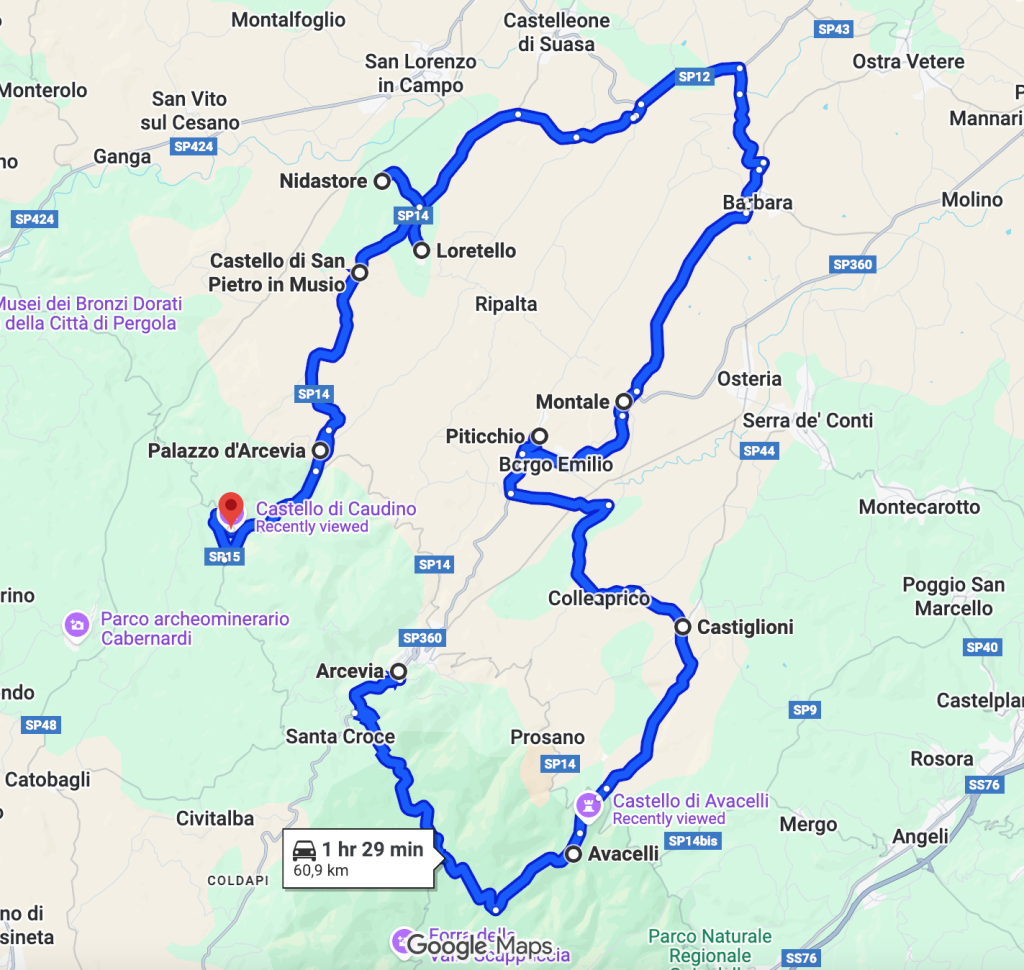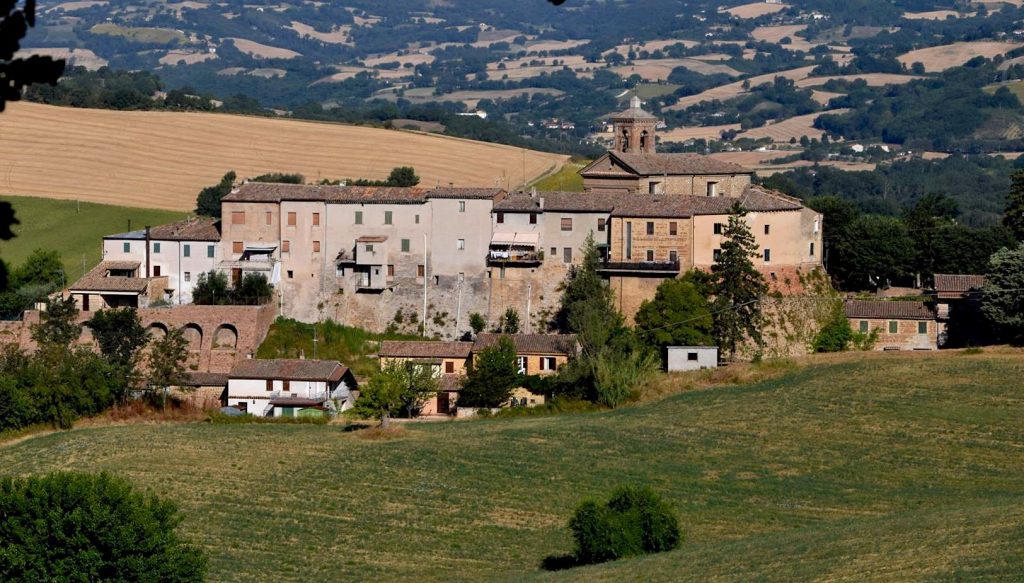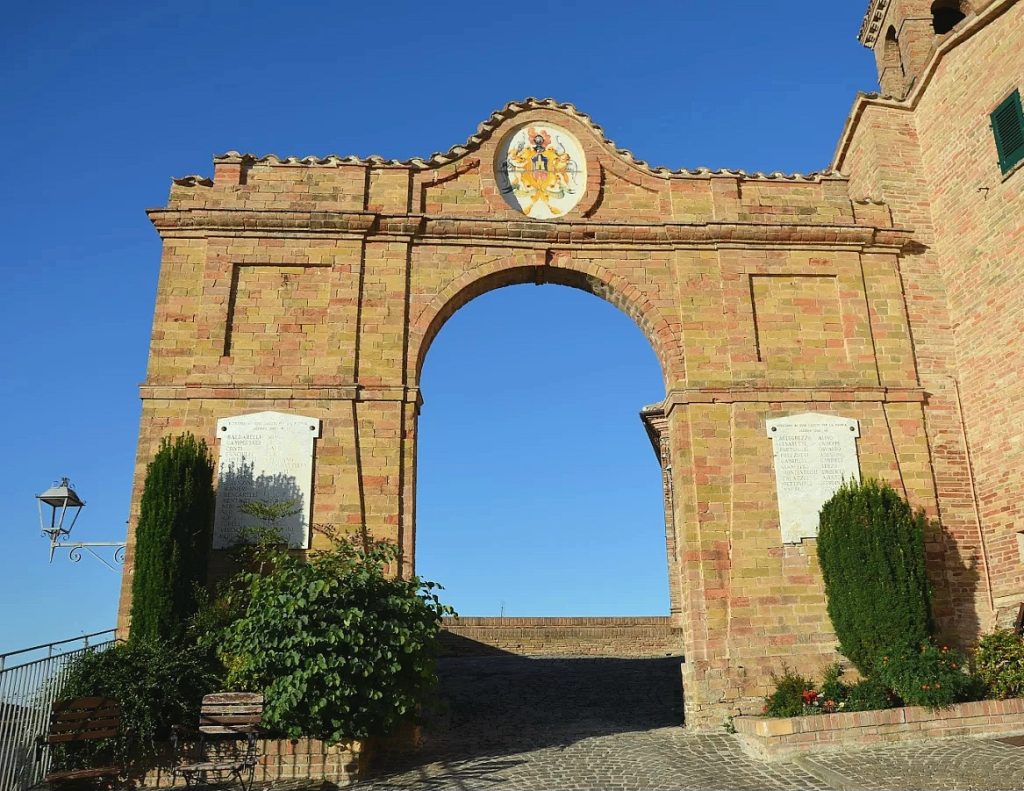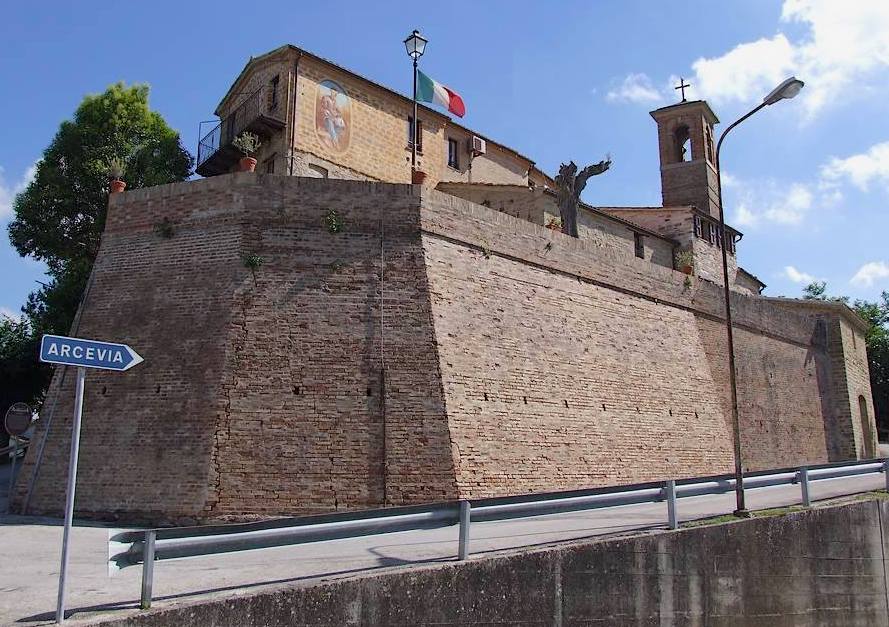Arcevia is a medieval town in the province of Ancona, surrounded by rolling hills and protected by ancient walls. Its historic centre is full of interest, with notable landmarks such as the Church of San Medardo and the Civic Archaeological Museum, which houses important prehistoric finds.
However, Arcevia is also known for its nine fortified villages, small, well-preserved hamlets that reflect the area’s long defensive history. The town sits close to the Gola della Rossa e di Frasassi Regional Park, making it an excellent base for exploring both cultural and natural attractions in this part of Marche.
The Nine Castles of Arcevia
The nine castles of Arcevia are Avacelli, Castiglioni, Caudino, Loretello, Montale, Nidastore, Palazzo in Arcevia, Piticchio, and San Pietro in Musio. These are ancient fortified medieval villages, dating mainly from the 13th and 14th centuries, that have preserved their original layout and defensive walls
Visiting the nine castles of Arcevia makes for a perfect day trip, but keep in mind that there are nine of them, and the full loop connecting them is nearly 60 km. In autumn, with shorter daylight hours, some planning is needed to visit them all before dark. Here you’ll find all the essential information for your trip.
Map of the itinerary
You can visit the castles in any order that suits you. The map below suggests a route starting from Arcevia and continuing through Avacelli, Castiglioni, Piticchio, Montale, Loretello, Nidastore, San Pietro in Musio, Palazzo d’Arcevia, and finally Caudino.

Avacelli
Avacelli stands on a panoramic ridge between the Misa and Cesano valleys. This small medieval village retains its defensive walls and narrow streets, preserving the character of a 13th-century fortified settlement. Notable landmarks include the Church of San Lorenzo, with its Romanesque architecture, and the Church of San Ansovino, known for its 15th-century frescoes.


Castiglioni
Castiglioni is a quiet hilltop hamlet that has kept its medieval street layout almost intact. The village walls and gateways are well preserved, and from its main square you can enjoy wide views over the surrounding countryside. The Parish Church of San Michele Arcangelo contains valuable artworks and serves as a focal point for the small local community.

Caudino
Caudino is one of the smallest of Arcevia’s castles, located on a gentle hill surrounded by fields and woodland. Though modest in size, it still shows traces of its fortified past in the compact arrangement of its houses and the remnants of its walls. The Church of San Pietro Apostolo is its main monument and features a simple yet harmonious façade.

Loretello
Loretello is among the best-preserved castles of Arcevia and one of the oldest, dating back to the 11th century. Its impressive arched bridge and surrounding walls immediately evoke its defensive history. Inside, visitors can explore the Civic Archaeological Museum, which documents the castle’s evolution and the broader history of the Arcevia area.

Montale
Montale sits in a quiet rural setting and maintains its medieval street grid within the remains of its walls. Though small, it has a peaceful and authentic atmosphere. The Church of Santa Maria delle Grazie holds artworks from the 16th century, and the surrounding hills are dotted with trails and viewpoints.

Nidastore
Nidastore occupies a strategic position near the border between Le Marche and Umbria, historically important as a frontier outpost. Its name means “nest of the goshawk,” a reminder of its military origins. The village still preserves the gate tower and stretches of its walls, while the Church of San Sebastiano displays several noteworthy frescoes.

Palazzo di Arcevia
Palazzo developed as a fortified village in the 13th century and later became one of the most prosperous of the nine castles. Its centre features the Church of San Michele Arcangelo and a number of elegant buildings from the Renaissance period. Palazzo also hosts small cultural events and exhibitions throughout the year, maintaining an active local life.

Piticchio
Piticchio is often considered the most picturesque of Arcevia’s castles, with perfectly preserved walls and towers enclosing a compact network of alleys. Walking through its gates feels like stepping back into the Middle Ages. The Church of San Sebastiano contains frescoes from the 15th century, and the village often hosts medieval-themed events and art exhibitions.


San Pietro in Musio
San Pietro in Musio is located on a hill surrounded by woods and farmland, offering panoramic views of the Apennines. It is smaller and quieter than most of the other castles, but its medieval layout and Church of San Pietro Apostolo reflect the area’s long history. It’s an ideal stop for travellers looking for peace and authentic rural scenery.

In Arcevia
Arcevia is not only about its nine castles, it is also worth visiting the town. It offers wide views over the valleys, and the historic centre is enclosed by well-preserved walls and features notable landmarks such as the Collegiata di San Medardo, the Civic Archaeological Museum, and several Renaissance palaces. Arcevia has a long history dating back to pre-Roman times, and today it combines cultural attractions with access to the natural landscapes.
Archaeological Museum
The Civic Archaeological Museum of Arcevia is located in the historic centre, inside the former San Francesco convent. It houses important prehistoric finds from the Monte Croce-Guardia area, one of the most significant archaeological sites in central Italy. The collection includes tools, ceramics, and burial objects from the Neolithic to the Iron Age, offering a clear picture of human settlement in the region over thousands of years. The museum is well-organised and provides an interesting stop for anyone interested in the ancient history of Le Marche.
Palazzo Comunale
The Palazzo Comunale, located in the central Piazza Garibaldi, it’s the oldest Town hall in Le Marche. Originally built in the 13th century and later modified during the Renaissance, it has long served as the seat of the town’s government. The façade features elegant arches and stone details typical of civic architecture in Le Marche. Inside, the building houses the council hall and several artworks that reflect Arcevia’s political and artistic history.
Museo Giocando
The Museo Giocando in Arcevia is a small but charming museum dedicated to toys and childhood memories. It displays a wide collection of vintage toys, games, and educational materials from different periods, offering a nostalgic look at how children used to play and learn. The museum is designed to be engaging for both adults and families with children, combining fun with cultural value. It’s an unusual stop that adds a lighter and more playful touch to a visit to Arcevia’s historic centre
Explore the Surroundings
Arcevia is well-positioned for exploring the inland areas of northern Le Marche. Within a short drive, you can reach a variety of interesting destinations:
- Gola della Rossa e di Frasassi Regional Park: a must-visit natural area with scenic trails, viewpoints, and the famous Frasassi Caves, among the largest cave systems in Europe.
- Serra San Quirico: a medieval hill town with fortified walls, narrow streets, and panoramic views; ideal for a short walk and lunch stop.
- Genga: known for the Frasassi Caves and the Temple of Valadier, a unique chapel set inside a mountain grotto.
- Corinaldo: the town of the La Piaggia Staircase, the Polenta Well, wine, and several folklore festivals.
Accommodations near Arcevia
Here are some options for accommodations near Arcevia:
Guided Activities near Arcevia
A list of guided and bookable activities can be found below:


Comments are closed.